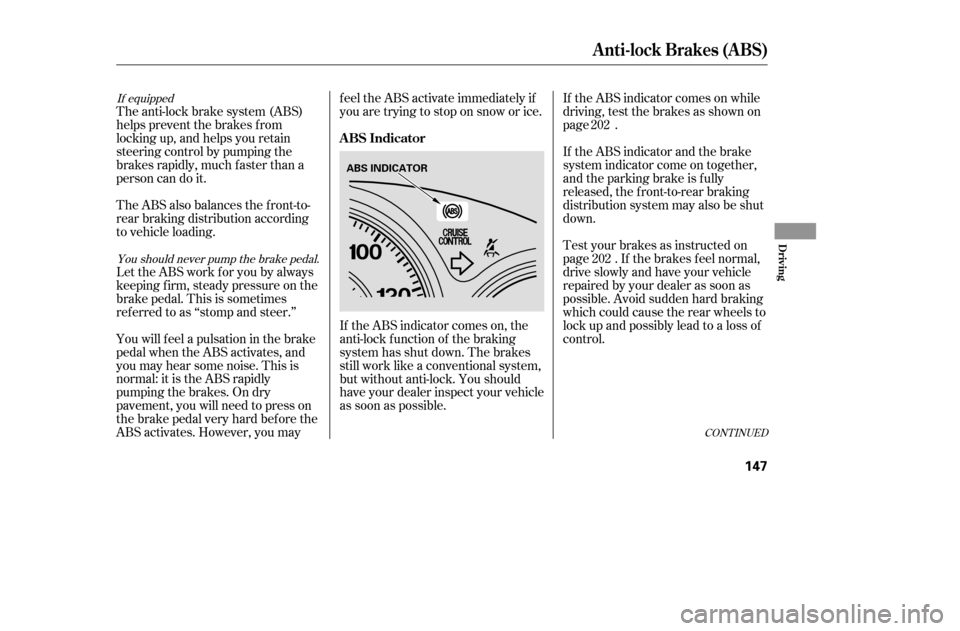Page 112 of 226
If equipped
Cruise control allows you to maintain
asetspeedabove25mph(40km/h)
without keeping your f oot on the
accelerator pedal. It should be used
f or cruising on straight, open
highways. It is not recommended f or
city driving, winding roads, slippery
roads, heavy rain, or bad weather.Accelerate to the desired cruising
speedabove25mph(40km/h).Press and release the SET/decel
buttononthesteeringwheel.The
indicator on the instrument panel
comes on to show the system is
now activated.
Push in the CRUISE button. The
indicator will come on.
1. 2. 3.
CONT INUED
Cruise Control
Using Cruise Control
Features
117
CANCEL BUTTON
RESUME/ accel
BUTTON
SET/decel
BUTTON
CRUISE BUTTON
Improper use of the cruise
control can lead to a crash.
Use the cruise control only
when traveling on open
highways in good weather.
�����—�����—�����y�
������
������y���
�(���%�������y���
�����y
Page 114 of 226

Resting your f oot on the brake or
clutch pedal causes the cruise
control to cancel.
Even with cruise control turned on,
you can still use the accelerator
pedal to speed up f or passing. Af ter
completing the pass, take your foot
of f the accelerator pedal. The vehicle
will return to the set cruising speed.
When you push the CANCEL button,
or tap the brake or clutch pedal, the
system remembers the previously
set cruising speed. To return to that
speed, accelerate to above 25 mph
(40 km/h) and then press and
release the RESUME/accel button.
The CRUISE CONTROL indicator
comes on, and the vehicle
accelerates to the same cruising
speed as bef ore.
Tap the brake or clutch pedal.
Push the CANCEL button on the
steering wheel.
You can cancel cruise control in any
of these ways:
Push the CRUISE button. Pressing the CRUISE button turns
the system off and erases the
previous cruising speed.
Cruise Control
Resuming the Set Speed
Cancelling Cruise Control
Features
119
�����—�����—�����y�
������
������y���
�(���%�������y���
�����y
Page 123 of 226

Some examples are:Larger or smaller wheels and tires
can interf ere with the operation of
your vehicle’s anti-lock brakes and
other systems.
Removing parts f rom your vehicle,
or replacing components with
non-Honda components could
seriously af f ect your vehicle’s
handling, stability, and reliability.
Non-Honda wheels, because they
are a universal design, can cause
excessive stress on suspension
components.
Raising your vehicle with a
non-Honda suspension kit can
af f ect the handling and stability.
Lowering your vehicle with a
non-Honda suspension kit that
signif icantly reduces ground
clearance can allow the
undercarriage to hit speed bumps
or other raised objects, which
could cause the airbags to deploy.
If you plan to modif y your vehicle,
consult your dealer.Modif ying your steering wheel or
any other part of your vehicle’s
safety features can make the
systems inef f ective.
Modif ying Your Vehicle
A ccessories and Modif ications
Bef ore Driving
129
�����—�����—�����y�
���������
�
�y���
�(���%�������y���
�����y
Page 127 of 226
Fasten your seat belt. Check that
your passengers have f astened
their seat belts (see page ).
Make sure the doors are securely
closed and locked.
Check the steering wheel
adjustment (see page ).
Check the adjustment of the
inside and outside mirrors (see
page ).
Check that any items you may be
carrying are stored properly or
f astened down securely.
Check the seat adjustment (see
page ).
Make sure all windows, mirrors,
and outside lights are clean and
unobstructed. Remove f rost, snow,
or ice.
Youshoulddothefollowingchecks
and adjustments bef ore you drive
your vehicle.
Check that the hood is f ully closed.
Check that the trunk is f ully
closed.
Visually check the tires. If a tire
looks low, use a gauge to check its
pressure. When you start the engine, check
the gauges and indicators in the
instrument panel (see page ).
1. 2. 14
3. 4. 5. 6. 7. 8. 9.
11.
10.
80
73
65 51
Preparing to Drive
134
�����—�����—�����y�
�������������y���
�(���%�������y���
�����y
Page 139 of 226

Check the brakes after driving
through deep water. Apply the
brakes moderately to see if they f eel
normal. If not, apply them gently and
f requently until they do. Be extra
cautious in your driving.
The hydraulic system that operates
the brakes has two separate circuits.
Each circuit works diagonally across
the vehicle (the lef t-f ront brake is
connected with the right-rear brake,
etc.). If one circuit should develop a
problem, you will still have braking
at two wheels.The f ront disc brakes on all models
have audible brake wear indicators.
If the brake pads need replacing, you
will hear a distinctive, metallic
screeching sound when you apply
the brake pedal. If you do not have
the brake pads replaced, they will
screech all the time. It is normal f or
the brakes to occasionally squeal or
squeak when you apply them.
Your vehicle is equipped with f ront
disc brakes. The brakes on the rear
wheels are drum. A power assist
helps reduce the ef f ort needed on
thebrakepedal.TheABS(on
models equipped) helps you retain
steering control when braking very
hard.
Resting your f oot on the pedal keeps
the brakes applied lightly, builds up
heat, and reduces their ef f ectiveness.
It also keeps your brake lights on all
the time, conf using drivers behind
you.
Constant application of the brakes
when going down a long hill builds
up heat and reduces their ef f ective-
ness. Use the engine to assist the
brakes by taking your f oot of f the
accelerator and downshif ting to a
lower gear. Braking System Design
Brake Wear Indicators
Braking System
146
�����—�����—�����y�
�������������y���
�(���%�������y���
�����y
Page 140 of 226

CONT INUED
The anti-lock brake system (ABS)
helps prevent the brakes f rom
locking up, and helps you retain
steering control by pumping the
brakes rapidly, much f aster than a
person can do it.
Let the ABS work f or you by always
keeping f irm, steady pressure on the
brake pedal. This is sometimes
ref erred to as ‘‘stomp and steer.’’
The ABS also balances the f ront-to-
rear braking distribution according
to vehicle loading.
You will f eel a pulsation in the brake
pedal when the ABS activates, and
you may hear some noise. This is
normal: it is the ABS rapidly
pumpingthebrakes.Ondry
pavement, you will need to press on
thebrakepedalveryhardbeforethe
ABS activates. However, you may feel the ABS activate immediately if
you are trying to stop on snow or ice.
If the ABS indicator comes on, the
anti-lock f unction of the braking
system has shut down. The brakes
still work like a conventional system,
but without anti-lock. You should
have your dealer inspect your vehicle
as soon as possible.
If the ABS indicator comes on while
driving, test the brakes as shown on
page .
If the ABS indicator and the brake
system indicator come on together,
and the parking brake is f ully
released, the front-to-rear braking
distribution system may also be shut
down.
Test your brakes as instructed on
page . If the brakes f eel normal,
drive slowly and have your vehicle
repaired by your dealer as soon as
possible. Avoid sudden hard braking
which could cause the rear wheels to
lock up and possibly lead to a loss of
control.
202
202
If equipped
You should never pump the brake pedal.
Anti-lock Brakes (ABS)
ABS Indicator
Driving
147
ABS INDICATOR
�����—�����—�����y�
�������������y���
�(���%�������y���
�����y
Page 141 of 226

It only helps with the
steering control during braking.
such as trying to take a
corner too f ast or making a sudden
lane change. Always drive at a safe
speed f or the road and weather
conditions.
Always steer moderately
when you are braking hard. Severe
or sharp steering wheel movement
can still cause your vehicle to veer
into oncoming traffic or off the road. on loose or
uneven surf aces, such as gravel or
snow, than a vehicle without anti-
lock. Slow down and allow a greater
distance between vehicles under
those conditions. Your vehicle is not designed to tow a
trailer, attempting to do so can void
your warranties.
A BS does not reduce the time or
distance it takes to stop the
vehicle.
A BS will not prevent a skid that
results f rom changing direction
abruptly,
A BS cannot prevent a loss of
stability. A vehicle with A BS may require a
longer distance to stop
Important Saf ety Reminders
Towing a Trailer
Anti-Lock Brakes (ABS), Towing a Trailer
148
�����—�����—�����y�
�������������y���
�(���%�������y���
���
�y
Page 145 of 226

�µ
�Ì
�Î �Î �Ì
�Ì
�Î
�Î
153
Canadian Owners Service the items listed at the indicated distance (or time, if given).
miles x 1,000
km x 1,000 10162032 304840645080 70
112 80
128 90
144 120192130208 150240
Check oil and coolant at each fuel stop
Check inflation and condition once a month
Every 10,000 miles (16,000 km) or every 1 year, whichever comes first Every 10,000 miles (16,000 km)
Every 20,000 miles (32,000 km) or every 1 year, whichever comes first
Every 30,000 miles (48,000 km) or every 2 years, whichever comes first
Inspect every 110,000 miles (176,000 km), otherwise adjust only if noisy
Every 120,000 miles (192,000 km) or every 6 years, whichever comes first
Every 110,000 miles (176,000 km) or every 7 years, whichever comes first
At 120,000 miles (192,000 km) or 10 years, then every 60,000 miles (96,000 km) or 5 years Every 3 years (independent of mileage)
See information on maintenance and emissions warranty, middle column, page .
Replace at 120,000 miles (192,000 km) or 6 years, then every 90,000 miles (144,000 km) or 5 years.
Replace at 60,000 miles (96,000 km) or 3 years, then every 40,000 miles (64,000 km) or 2 years.
Check engine oil and coolant
Check tires
Replace engine oil
Rotate tires (follow pattern on page 181 )
Replace engine oil filter
Check front and rear brakes
Check parking brake adjustment
Inspect the following items:
Tie-rod ends, steering gearbox, and boots
Suspension components
Driveshaft boots
Brake hoses and lines (including ABS)
All fluid levels and condition of fluids
Exhaust system
Fuel lines and connections
Inspect and adjust drive belts
Replace dust and pollen filter
Replace air cleaner element
Replace spark plugs
Inspect valve clearance
Replace automatic transmission fluid
Replace manual transmission fluid
Replace CVT fluid
Inspect idle speed
Replace timing belt, inspect auto-tensioner and water pump
Replace engine coolant
Replace brake fluid 6096
100160110176 140224
Follow the maintenance schedule for severe conditions. 152
:
1:2: 1
2
Maintenance Schedule for Normal Conditions
�����—�����—�����y�
���������
���y���
�(���%�������y���
�����y